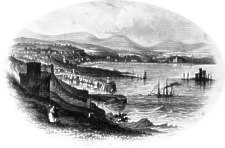
[From Johnson's Guide, 1850]
This town is the commercial metropolis of the Island and is beautifully situated on a fine bay of the same name. The name is derived from the two rivers Dho and Glas, which unite about a mile from the town, and has a commodious harbour for vessels of considerable tonnage, the depth of water, at spring tides, being from twelve to twenty feet.
The town lies seventy-two miles north-west of Liverpool, forty south-west of Whitehaven, seventy five north-east by east. of Dublin, and one hundred and forty-four south of Greenock. Its convenient situation for commerce, the circumstance of its being the only port in the Island for the reception of License Goods, and the constant intercourse with the surrounding countries, have given it a great superiority over the other towns of the Island, and placed it on a level with many of the smaller sea-ports of England and Ireland. Some parts of it are of great antiquity, but until the Revestment it was little better than a fishing village, the cottages being built of sods or clay, thatched, and placed at random without the slightest attempt at regularity. The older streets to this day remain crooked, narrow, and irregular; but since the commencement of the present century, several fine streets and terraces have been built, and villas scattered here and there contribute to the beauty of the place in no small degree.
The general outline of the town is triangular, and from the hill behind Fort Anne it presents an appearance rudely resembling the three legs which adorn the Insular escutcheon. From the heights above the Lighthouse, which stands at the enterance of the bay, the view was taken which forms the frontispiece of this volume. From every point of these heights the, landscape is most interesting. From the extreme height, it is no unusual thing to obtain a view of the Cumberland Hills, and Welsh Coast. The bold and rugged mountains-the open sea-ever a magnificent object whether in storm or calm, and the town stretching beautifully along the margin of the bay, form a combination rarely to be met with, of the grandest of Nature's efforts with the productions of man's wealth and taste. The following stanzas, composed by Mrs. E. S. C. Green expressly to illustrate the Frontispiece, will convey to the reader some of the many thousand varied emotions, which the actual contemplation of the scene itself is so well calculated to inspire.
DOUGLAS BAY.
Oh emerald waves! to me your murmur cometh
Like the dim music in an ocean shell,
Calling me back with fond familiar voices,
' To tread again the shores beloved, alas! too well !I look far down into your gleamy waters,
And listen for the songs that came of yore,
With a faint cadence from the sea maid's dwelling
Her spell-wrought mist still guards the enchanted shore.But far away the Mermaid has departed,
No music on the midnight sea is cast;
Yet in the murmurs of the wave remaineth
A low-sweet-fitful sound-an echo of the pastOh lovely are ye, ye encircling waters,
Girding with brightness the romantic shore,
With faery sails in the far sunlight gleaming,
And silvery shower-drops from the glancing oar.There the green headland with its crowning turrets,1
The far grey cliff, the clear sparkling sands,
And the sweet homes of peace, whose groves and gardens
Blossom in beauty as the view expands.No fairer scene may to the poet's spirit,
Beneath the blue skies of Italia smile,
Than thine, oh lovely bay, that proudly guardest
With thy far-spreading waves dear Mona's Isle!The harvest hour returns2-how many ~'shes
Go with that moonlight navy's spreading sails!
From many hearts the fervent,prayer arise !
That hope, yet tremble, as the breeze prevails.Husband and lover, brother, son, and sire,
Go forth upon thy waters; may they come
With triumph back again, with shout and welcome,
Their perils past, to bless their Island home!Fair shores of Mona fond remembrance hallows
Your changing scenes thro' mist, and sun, and shade,
A cherished dream of beauty unforgotten
Till life itself shall from your minstrel fade1 Fort Anne and Harold Tower.2 The Herring Fishery.
Douglas Bay has been an object of much interest of late years, not only to the traveller in search of the picturesque, but to the merchant and the philanthropist. Its situation in the midst of the Irish sea, its almost equidistance from the circumjacent coasts, and its great capabilities of improvement have pointed it out as the most desirable locality for a Central Harbour of Refuge, and with this view it has been the subject of survey and experiment for many years. The Commissioners of Harbours have made numerous representations to Government on the subject. In 1835, in consequence of these representations, Sir John Rennie was sent to survey Douglas bay, with a view to the formation of a Refuge harbour. A Plan and Report were prepared and submitted to the Dock Trustees of Liverpool for approbation. They, in turn, sent their marine surveyor, Capt. Denham, to make further plans and reports. Every additional inquiry made the advantages and practicability of the scheme more apparent. As yet, however, the great expense of the works has deterred Government from advancing money for the purpose, and as any funds which could have been raised in the Island would have been totally inadequate, the project seemed abandoned, when the recent discovery of Captain Tayler has again brought it before the public. A Memorial has been forwarded to Government from the Inhabitants of Douglas, praying for assistance in the construction of a Floating Breakwater, and a correspondence opened with the National Floating Breakwater Institution. Should this plan, after a fair trial, prove advisable, it is not improbable that we may at length see the object accomplished which has been so long desired. That the establishement of a Refuge Harbour would be of the greatest advantage to the Island, and to Douglas especially, will not for a moment be questioned ; while, as a matter of philanthropy, the amount of life and property which will thereby be saved from destruction, will be sufficiently great to justify any exertions which may be made in the promotion of the undertaking.
The present harbour of Douglas, though sufficiently commodious for the shipping ordinarily resorting to it, is, in stormy weather, and particularly with a S. E. wind, very unsafe. The only defence it has is that afforded by a jetty, extending about two hundred yards from the rocks below Fort Anne, but this does not by any means supply the requisite protection, nor prevent the sea rolling inward, causing the vessels to beat against the quays, About the beginning of this century, a handsome pier was erected by Government at a cost of £22,000. It is five hundred and twenty feet in length, and forty in breadth, is well flagged, and has a bulwark four or five feet high running down the northern side, and around the projecting and raised extremity, on which stands an elegant Light house, forming, m conjunction with that erected by the Commissioners of Harbours on Douglas Head, a landmark, distinguishing the harbour at a great distance. Beyond affording a basement for the light house, however, and a fashionable promenade for the inhabitants of Douglas, the pier is of no use whatever, and as a very slight additional expense would have sufficed to carry a stone Breakwater to St. Mary's rock, it is to be regretted that better advice had not been obtained before so important a work was commenced. The Light-house on the Head is a very valuable addition to the harbour, and is visible as a star of the first magnitude, at a distance of fifteen miles.
THE TOWER of REFUGE on St. Mary's or Conaster rock is a most interesting feature in the landscape. It was erected in 1832, at the suggestion of Sir William Hillary, Bart., by whom the first stone was laid. The object proposed by the benevolent founder was to afford refuge for the crews of vessels which should be driven into the bay by stress of weather, and cast on the rock, and accordingly a bell is hung in the tower by which they may make known their situation to the town.
In connection with this subject it may be proper to notice the Association formed in the Island as a branch of the Royal National Institution for the preservation of life from Shipwreck. Through the exertions of this society the four chief sea-ports of the Island have been supplied with life-boats,, and a complete set of Manby's apparatus. Since the year 1825, when the association was formed, upwards of one hundred persons have been rescued from danger, if not from death. ; Such results must be gratifying to every benevolent mind, and amply repay any anxiety or expense which way have been necessary to obtain them.
THE PAROCHIAL DISTRIBUTION of Douglas is remarkable, presenting a very curious anomaly. As relates to spiritual matters, the town is in the parish of Braddan; but as relates to the civil jurisdiction, in that of Onchan. On this subject the following interesting extract of a letter from the Rev. Edward Craine, Vicar of Onchan, will be found to supply all that is accurately known on the subject.
"In respect to the civil and ecclesiastical limits of this Parish and Kirk Braddan,-in the former jurisdiction we include the whole of Douglas, but in the latter we only go as far as the stream at the quarries, near the sands, and which supplies the town with water. But some are of opinion, that we extend as far as the rivulet near Mrs. McCrones house. This is, however, doubtful. When a person residing in Douglas is cited in the Deemster's Court, he is called an inhabitant of Onchan, but when the same individual is cited in the Vicar-General's Court, he is called an inhabitant of Braddan. This is a very strange distinction, and cannot be satisfactorily accounted for. I asked an intelligent old man, who had resided nearly all his days within a few paces of the northern boundary of the two parishes, if he ever heard what caused this extraordinary difference, and he assigned a cause as extraordinary as the distinction itself. He informed me that he understood, there had been, long ago, a minister of Braddan, who was also Vicar-General, and that the living, being inadequate to support him, his Bishop gave a large portion of Kirk Onchan to his parish to improve his income. But this account could not be true, as no Bishop had the power of doing so ."
THE PUBLIC BUILDINGS of Douglas are not numerous but considering the limited capital of the Island, are distinguished by considerable taste and elegance. First in interest and importance are THE CHURCHES, which are four in number ; though, to speak correctly, they should be called Chapels of ease to the Church of Braddan, in which parish the greater part of Douglas, quoad spiritualia, is included.
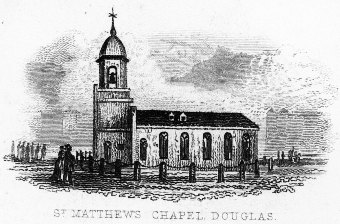
ST. MATTHEW'S CHAPEL, in the Market-place, is an old and ungainly edifice. It was erected in 1711, and consecrated by Bishop Wilson. It affords but slender accommodation, and stands in a very inconvenient situation, being almost in the centre of the only open space in the town. St. Matthew's has the only public horologe in Douglas. It is placed in the tower at the western extremity, and the dial may be seen from the foot of James Street, and from the Coffee-room of the British Hotel. Service in the Manks language is performed in this Chapel on Sunday evenings at three o'clock. The Incumbent is the Rev. John Cannel.

ST. GEORGE'S CHAPEL stands on the hill to the west of Athol Street, and is a capacious building. Externally, it has not much to boast in point of Architecture, having only a plain square tower, without ornament of any kind. The interior, however, is fitted up with much taste. To the left of the pulpit is the Bishop's throne. The organ of St. George's is remarkably sweet, and, for its size, possesses considerable power, which qualities are skilfully displayed by Mr. Davis, the organist. The choir is also good, being assisted by several gentlemen, to whose labours the congregation are much indebted. A spacious cemetery surrounds the Chapel, a portion of which is reserved for the remains of persons drowned on the coast.
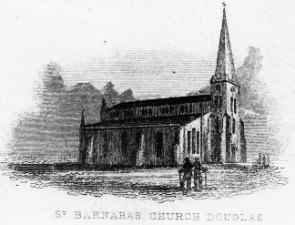
ST. BARNABAS' CHAPEL, in Fort Street, was erected by subscription a few years ago, with a view of providing accommodation for the poor. It is the most elegant building in Douglas, though unfortunately it is so completely obscured by the mass of houses around it that a stranger might pass it unobserved. The eastern window is composed of a fine series of lancet; shaped compartments, but its beauty is completely hidden from the eye. The interior is well calculated to excite admiration, though the huge pillars, rising from the floor, and forming the buttresses of massy arches supporting the roof, effectually conceal the pulpit from half the occupants of the gallery. The Chaplain is the Rev. Wm. Carpenter, D.D., who is assisted by the Rev. Philip Dowe.
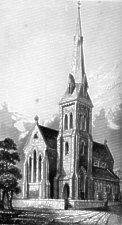
NEW CHURCH of ST. THOMAS.-This may fairly be called the model Church ofthe Island, it is now in course of erection by voluntary contributions, from designs by Ewan Christian, Esq. The plan embraces a nave and aisles with a chancel, and a lofty tower at the N. E., angle, which with the spire will be 180 feet in height ; to realize this leas; ing feature and appropriate adjunct to the educe, a shilling subscription is opened and it is hoped that philanthropic individuals, and benevolent visitors will assist the committee in their endeavours to raise its tapering summit as a land-mark for the mariner, who pursues a perilous avocation athwart the bosom of the great deep.
The purple coloured lime-stone masonry forming the quoins of the buttresses, and the dressings of the windows and doorways is brought by coasting vessels from Port-le-Mary, near Castletown, this is very durable, being harder and more compact than Granite, of a fine grain and capable of taking a high polish. The steps at the entrances of St. Paul's Cathedral, London, are from this quarry and were presented to the Dean and Chapter, by our late lamented Bishop Wilson.
The shale stone composing the rubble walling is laid in random courses and is procured from the " Lough" quarry on the road to Onchan, where the stram may be seen running in nearly a verticle direction.
| Total length of Church |
103 ft.
|
| width |
53 ft
|
| height |
44 ft
|
It will contain 1031 sittings, of which 513 are to be free and unappropiated for ever.
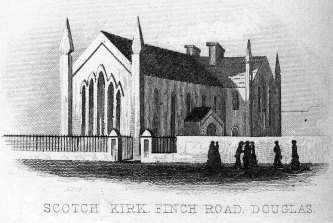
THE SCOTCH KIRK is a neat little building, at the top of Finch Road, in the Gothic style, with a house attached for the Minister's residence. The present Minister is the Rev. James Cleland.
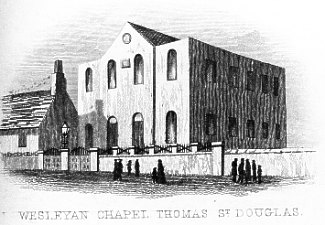
The Wesleyan Methodists have two good Chapels in Douglas, one in Thomas Street, affording accommodation for a thousand persons. The pulpit is at the east end of the Chapel, with a singing gallery behind the pulpit; there is a neat little organ, the choir is well conducted by Mr. Cretney. The Chapel is well finished and affords good accommodation to the poor to whom the gospel is preached. The old Chapel adjoining the new one, as now used as an Infant School on week days, and for a Sunday School.
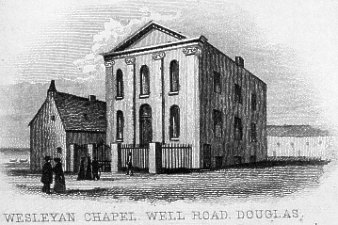
Well road Chapel will seat six hundred persons, it is finished in a neat style ; beneath the Chapel there is a spacious School, lofty, airy, and well lighted, in which there is on the books 126 boys, taught by voluntary subscription.
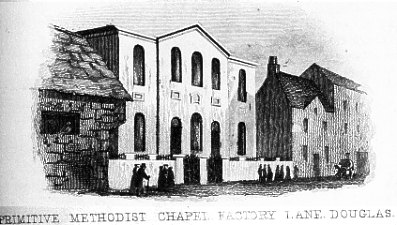
The Primitive Methodists have a good Chapel in Factory-lane, fitted up.in a plain, neat style, which is well attended and capable of accommodating about 800 persons. They have a large Sabbath School taught in the Chapel.

The Club-room at the east end of Athol Street, has been fitted up as a Chapel by the members of the Church of Rome.
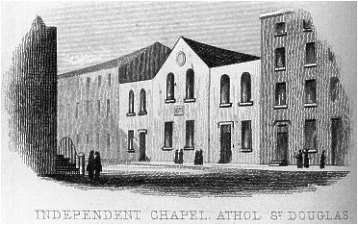
The Independents have also a small comfortable Meeting-house in Athol Street.
The CUSTOM-HOUSE is situated in the Market-place, and affords excellent accommodation for business. The large room has recently been thrown open to the public, who formerly entered from the back. The Harbour Office, and Searcher's Office, are in Bond Street, at the back of the Custom-House.
THE COURT-HOUSE is an unpretending little structure at the top of the pier. His Honour, Deemster Heywood, holds a Court here every alternate Monday, during term, and His Worship the High bailiff, James Quirk, Esq., holds a Court every Saturday. The Seneschal's Office is in St. Barnabas' Square.
THE WELLINGTON MARKET is a handsome and commodious building, with a spacious entrance from Duke Street, and side entrances from Factory-lane and Drumgold Street. It was erected some years ago, with a view of providing accommodation for the country people on Market Days ; but the force of ancient usage has hitherto proved too strong to allow of a change from the open Market-place on the quay. Until the inhabitants themselves determine to purchase in preference from those who have stalls in the covered building, it cannot be expected that the sellers should voluntarily incur even the trifling expense to which the rent of a stall would subject them. The new building, therefore, remains almost untenanted, and it is to be feared, that the occasional hire of the ball which forms the upper story, and is let for public meetings, concerts, &c., will afford but a scanty remuneration to the proprietors.
THE ODD FELLOWS' HALL, in Athol Street, is a very elegant structure, recently erected by a body of shareholders, members of the Independent Order of Odd Fellows in the Isle of Mann District. The primary design of the erection was to afford accomodation for the meetings of the Douglas Lodges in the District, and secondarily, to provide a handsome hall for public dinners, balls, and concerts. A large and convenient kitchen has been constructed in the lower part of the building, and several shops and private offices fitted up, the rent of which will remunerate the proprietors for their investment. The Hall above is the largest room in the Island, being capable of accommodating 400 persons at dinner, and a gallery, with seats for 150, has been erected at the north side of the hall.
Amongst the improvements in the town of Douglas may be instanced, the spacious building in Athol St., recently erected for a drapery Establishment, by Mr. Falkner, of Manchester. The elevation exhibits three stories, the basement of which presents a series of closely arched windows, the second series giving light to the gallery, and the upper portions ; the interior is lofty, expansive, and imposing, and is divided by a gallery to which access is obtained by an elegant and spacious staircase, the area of the premises is about forty by sixty feet.
THE HOUSE of INDUSTRY is situated on the eminence at the back of Harris Terrace, and affords an asylum for upwards of seventy aged and infirm persons. Nearly 100 out-door pensioners are also relieved by this excellent institution, which is entirely supported by subscriptions, by donations of money and food, and by annual collections in the churches. The building is ;neat, and the situation airy and well suited to the purpose.
THE DAILY AND SUNDAY SCHOOL in Athol Street was erected in 1811, for the education of the poor, on the Lancasterian system, in the principles of the Church of Enpland. It is capable of receiving 1000 children, but the average number is 320. It is supported by subscriptions and collections.
AN INFANT SCHOOL has been erected in Barrack Street, capable of accomadating 300 infants. There is another Infant School in connection with St. Barnabas' Chapel, in Cattle Market Street.
THE ISLE OF MANN LIBRARY, On the Pier, was founded about thirty years ago, and still exiets, though in a comparatively languescent state. The Reading-room originally connected with it has become a matter of history, and the library, though containing 1,600 volumes, has increased but slowly. Strangers are admitted to the use of the Books, on the recommendation of a shareholder, and on subscribing five shillings.
A MECHANICS' LIBRARY was founded several years ago, but as yet has not met with much encouragement. PUBLIC CIRCULATING LIBRARIES are kept by Mrs. Quiggin, Custom-House Quay; Mr, Mylrea ; S. Johnson ; Mr. Kerruish, Duke Street ; and John Cain, Great Nelson Street.
The United Service Club-room, and Commercial News-room is on the Pier.
Three Newspapers are published in the town of Douglas; a large number, when it is considered that the whole oppidan population of the Island is under 15,000. They are chiefly, however, supported by Advertisements, which, from the absence of cluty, are inserted at very low charges, compared with those of English Newspapers. The Manx Sun was established in the year 1810, under the name of " The Rising Sun," by Captain Colquitt. This paper is Conservative. Mona's Herald is published by Mr. R. Fargher. The Manx Liberal was established by Messrs. Penrice and Wallace.
DOUGLAS possesses several excellent HOTELS. The principal are the British Hotel, in the Market Place ; the Victoria, and the York, on the Parade; Redfern'sHotel, James. Street ; the Adelphi Hotel, Church street ; the Fleetwood Hotel, North Quay ; and the Saddle Inn, Queen Street. These houses afford excellent accommodation, being quite equal to the generallity of Commercial Hotels in England. There are several comfortable Hotels of the second class, which it is unnecessary to specify in this place.
FORT ANN HOTELwas built by the late celebrated Mr. Whaley, and was for many years the residence of Sir William Hilliary, Bart. ; it has long been considered one of the most beautiful Marine Residences in the United Kingdom. The situation never fails to arrest the attention, and raise the admiration of the visitor when entering the Bay of Douglas. Amongst the numerous objects of attraction on the margin of this beautiful bay, Fort Ann holds a proud distinction, seated upon a throne which appears raised by nature for her reception, she sits like another lady of the lake surrounded with the charms and grandeur of a vast expanse of Ocean ; bounded only in the distance by the bold profile of the Cumberland Hills; the elaborate taste which is displayed in the arrangement of the grounds and mansion, of themselves recommend it to all who appreciate a happy combination of the charms derivable from a panoramic view of the Sea, Woodland, and City; it is now used as a spacious Hotel, under the skilful management of Mr. J. Marshall. The frontage of this splendid ediface is one hundred and four feet ; the interior is lofty, spacious, and airy, and has been fitted up by Mr. H. with superb furniture of the most modern taste.
CASTLE MONA HOTEL. This superb edifice is about a mile from Douglas, situated on the margin of the bay, at its centre. It was built by the late Duke of Athol, at an expense of nearly £35,000, and was occupied by that nobleman as a private residence. The Castle presents the appearance of a square solid building, with a wing at the southern side. The exterior is faced with stone from the Isle of Arran. The design of the Duke included a north wing, the foundations of which were raised to the surface of the ground at the time of the erection of the principal structure, but the building has never yet been completed.
Shortly after the final sale of the Island by the Duke of Athol in 1829, four gentlemen purchased the Castle with about 180 Acres of land attached to it. The mansion was converted into a hotel, and the land marked out in building lots for sale. The first part of the speculation has been abundantly justified by the success of the establishment, which affords the most princely accommodation, and every luxury which the most fastidious visitor may desire. Beautiful walks and gardens surround,the Castle ; a billiard-room, and hot and cold baths are fitted up in the interior; and every convenience is afforded to those who love the limpid wave of ocean. In short, the establishment of the Castle is equal to the first in the kingdom, and has contributed in no slight degree to the prosperity of the Island, by the numerous visitors attracted by the splendid, and yet economical, manger in which they are enabled to enjoy the purity of the air and sea.
On the summit of Falcon Cliff immediately adjoining the pleasure grounds attached to Castle Mona, is the residence of Mr. Jackson, formerly of Stockport, recently erected by himself; the building is in the castellated style, and from its commanding site, and its adaptation to the character of the surrounding scenery ; it is an object of general attraction and an ornament to the Bay. The approach from the Shore Road, is through a lodge in the same style of architecture, over which a large room has been erected which is fitted up as a public Chapel, and where divine service is regularly maintained, the Minister is the Rev. William Carry, Stally-brass, son of the well known Missionary to Siberia, of that name.
THE VICINITY of DOUGLAS is highly picturesque, being diversified by mountain and valley, wood and stream. The circuit is not a long walk for an active pedestrian, and the beauty of the country will amply repay the trouble, and the sacrifice of a morning. A route, which will successively present all the interesting features of the vicinity, may be arranged in the following order.
Passing over the bridge, which is now widened to the extent of six or eight feet, and turning to the right into the Castletown road, the visitor in a few minutes arrives at the gates of the Nunnery grounds, which are open to the public by prescriptive right enjoyed from immemorial ages, and are a favourite resort in the summer season. Many a tale of love has been whispered beneath the shadows of those old trees, and feelings there find utterance, which, if known at all to the Nuns of old, were crushed and chilled by the leaden influence of their vows. There is a fine moral in the fact, that the groves around a former convental abode, smile in the present day, on the altar of the heart's affections which has been erected within the sacred precincts whence those affections were so long banished. Of the old Nunnery, said to have been erected by the celebrated Bridget in the early part of the sixth century, scarce a vestige remains, except part of the wall of the old chapel, and the gateway, which is still surmounted by the old bell. The Abbess who presided over the society of recluses was for many centuries a person of considerable importance, being a Baroness of the Isle, and having authority to hold courts for the trial of her vassals in her own name, independently of the jurisdiction of the lord's courts. The modern building, and the fine estate around it, are the property of General Goldie. It is a very beautiful mansion, and enjoys a most luxurious prospect on every side. A road winds round the grounds by the banks of the river, and conducts through four fields, to a branch road uniting the main roads to Castletown and Peel. Near the point at which the visitor enters this road is the tasteful villa of Ballaughton ; Harcroft, Millmount, Spring Valley, Farm Hill, and Pulrose are also in this neighbourhood. After passing through two fields in turning to the right, a substantial wooden bridge leads across the river to the Peel road, on the high ground above which five beautiful villas arrest the attention. To the extreme right is Belmont, the seat of G. W. Dumbell, Esq., which is at some distance from the road ; the second is Thornton Lodge, :the property of Samuel Harris Junr. Esq.; the third Burleigh, the property and residence of F. B. Byne, Esq. ; the others are Mount Vernon the property of J. Curran, Esq. ; Ballabrooie the property and residence of Robert McGuffog, Esq., Collector of the Customs of Douglas ; which the visitor, proceeding westward along the Peel road, will pass in succession.
Half a mile further on is the Quarter Bridge, from which an excellent view may be had of Kirby, a elegant mansion surrounded by thriving plantations, the property of Sir George Drinkwater,and residence of C. R. Ogden, Esq. It was built by the late Col. Wilks, from whose daughter, Lady Buchan, Sir George purchased it, and by whom the estate has been greatly improved. The river Doo winds through the grounds, and unites with the Glas a little below the Quarter Bridge.
The visitor now proceeds up a road to the right of the bridge, and will observe the'mansion of Port-e-Chee, formerly the residence of the Duke of Athol, It is now the property of Sir George Drinkwater. Tromode, the seat of Mr. W. Moore ; the Linen Manufactory of Mr. Moore, at some distance up the river, and an old fortification called Castleward, are also worthy of attention. The road passes over the high ground which overhangs Douglas, and extends to Kiondroghad, for such was the ancient name of the village of Onchan, the latter being, to speak strictly, the designation of the parish. In every direction, beautiful villas are to be seen. Woodburn, the property of Mrs. Harrison ; Glencrutchery, J. Schaw, Esq. ; Bemahague and Summer Hill, of the Hon. Deemster Heywood; and the Hague, the residence of McWilliam, Esq., are all well worthy of observation.
At the village, in which is the Nursery Grounds of A. Spittal, Esq., open for the inspection of visitors, the visitor falls into the Ramsey road, and returns to Douglas by the Sands. From the side of a steep hill descending from the village to the shore, a flight of steps leads to the reservoir which supplies the town with water. It is under the management of the Waterwork Company, and the water is of remarkable purity. To Mr. James Kewley, native engineer, and several other spirited individuals, the Inhabitants, of Douglas are indebted, not only for a supply of excellent water for the table and culinary purposes, but for a never-failing reserve in cases of fire, which is gratuitously afforded by the Company, one of the most flourishing in the Island.
At the foot of the hill a turn to the left takes the visitor past Strathallan Crescent to Derby Castle, a, handsome castellated mansion, beautifully situated and built a few vears ago by Major Pollock, of Strathallan Lodge. The walk along the Sands is extremely beautiful, being adorned with a series of elegant villas and cottages, among which those of R. Simpson, Esq., and Major Warburton, deserve especial notice There is also an excellent family Hotel kept by Mr. William Hill, with extensive accommodations. Passing Castle Mona, several handsome rows of houses will be observed on the space extending to the gates, which constitutes the Castle Lawn. From the Castle gates, a road leads to the right, connecting the Sands with the cross-road from the Quarter Bridge to Kirk Onchan, and passing Stanley Terrace, a tasteful row consisting of about twenty houses. Behind Stanley Terrace is an extensive piece of land which was purchased with Castle Mona in 1832, for building. The plan of a small town was formed, with a Church and Hotel, but has never been carried into execution. Several good houses and terraces have, however, been erected, and the situation is in every way so eligible, that there could be little doubt of the speculation eventually succeeding. Returning to Douglas, the retired mansion of Villa Marina will be observed. It was built by the late Colonel Stewart, and at his decease, was purchased for a Boarding School by the Misses Dutton, a purpose to which its seclusion and airy situation admirably adapt it.
We would however recommend a very short ramble up Prospect Hill, and along Woodburne road, to the right of which will be seen, after passing the House of Industry, several splendid mansions ; on the eminence above St. Thomas' Church, on the left are several beautiful mansions just built; proceeding onward for a quarter of a mile, turning down Lovers Lane, you come to Derby Square, embracing in all about eight and a half Acres of land ; two Acres of which in the centre are tastefully laid out as pleasure grounds, and richly planted with Evergreens ; many of the dwellings are already erected ; when completed, there will be 77 houses in the Square three stories high. There will be twenty dwellings in Derby Terrace, which is to face Lovers Lane, two stories high.
The hasty walk round the town of Douglas which has been sketched above, though it brings before the eye of the visitor every point of prominent interest in the vicinity, still leaves room for more extended perambulations, which must be left to the discrimination of the visitor. There is scarcely a town in the kingdom which can boast of environs so generally attractive, and no where will a stranger find so many objects of interest collected within so small a compass. The cause of this is to be found in the variety of character which the society of Douglas presents. Almost every nation in the world, every rank in the social scale, every profession, every trade, finds a representative in Douglas; and the natural result is, that all around are to be observed marks of taste, diversified as the character of the individuals from whonf they have proceeded.
This remark, indeed, is applicable to the land generally, which has been chosen as a residence by hundreds of families of every grade, who find health, retirement, education for their children, and a moderate enjoyment of the luxuries of life, within their reach, and, by a generous but unostentatious hospitality, contribute in turn to render the Isle of their adoption delightful to the thousands of casual visitors, whom each returning summer brings to the shores. The sportsman finds on her hills, the angler in her streams, the objects of their respective pursuits ; the invalid finds his pilgrimage ended at the temple of Hygeia ; and the man of letters may meet not a few of congenial sentiments, whose intercourse will relieve the monotony of retirement, and aid him in those delightful investigations in which his talents and his tastes have already invited him to engage.
|
|
||
|
|
||
|
Any comments, errors or omissions gratefully received
The Editor |
||